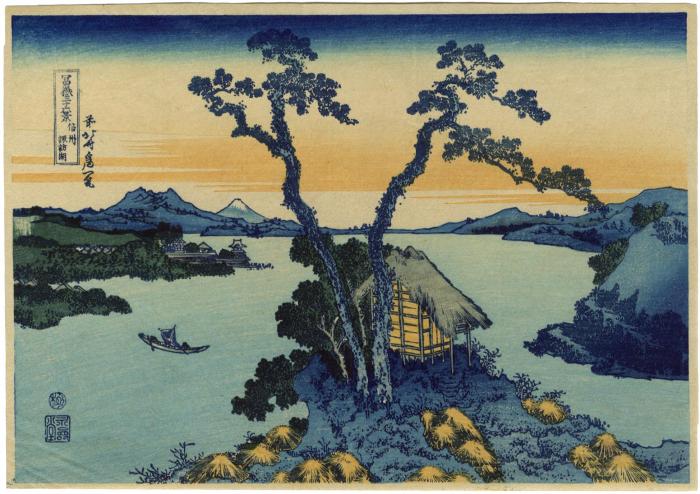Katsushika Hokusai (葛飾北斎) (artist 1760 – 1849)
20th century copy of Hokusai's Lake Suwa, Shinano Province (Shinsū suwa-ko - 信州諏訪湖) from the series Thirty-six Views of Mt. Fuji (Fugaku sanjūrokkei - 富嶽三十六景)
ca 1940
9.75 in x 6.75 in (Overall dimensions) Japanese woodblock print
Signed: Saki no Hokusai Iitsu hitsu
前北斎為一筆
Publisher: Nishimuraya Yohachi
Censor seal: kiwame
Museum of Fine Arts, Boston - original aizuri-e version without publisher or censor's seal
Google maps - Lake Suwa
Royal Museums of Art and History, Belgium (via Cultural Japan) - an original edition
Reprint of Hokusai, originally published circa 1830.
***
In a description of the original print in Hokusai and Hiroshige: Great Japanese Prints from the James A. Michener Collection, Honolulu Academy of Arts on page 71 it says:
"Lake Suwa, a body of water about 3 miles long and 2½ miles wide, lies in the Suwa basin, about 120 miles west of Edo, in Shinano province (present-day Nagano prefecture). Around the edge of the lake, there developed towns including Kami Suwa and Shimo Suwa (Upper and Lower Suwa, respectively). Kami Suwa prospered as a town connected with and ancient castle that was once occupied by the famous warrior Takeda Shingen. Rebuilt in 1590, it was reinstated as a holding of the Suwa daimyo family by the shogunate. The district of Suwa was also located where two major highways converged - the Kōshū and the Kiso roads. The latter (also called the Nakasendō Road) ran through the mountainous regions and connected Edo and Kyoto.
In this scene, the lake is viewed from a high position somewhere along the shore. The only recognizable landmark here is the Takashima Castle, seen left of the center and just belwo Mount Fuji, at the tip of he caped filled with houses. This must comprise the village of Shimo Suwa. Today the castle is located inland; it is presumed that the waters of Lake Suwa have receded since Hokusai's time.
In the center foreground two trees, which rise to the edge of the print, stand before a house or a shrine. It is said that the mountain is so far from the lake that it can be seen only on a fine day."
landscape prints (fūkeiga 風景画) (genre)
blue prints (aizuri-e - 藍摺絵) (genre)
Nishimuraya Yohachi (西村屋与八) (publisher)
Mount Fuji (富士山) (genre)
